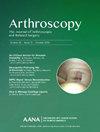No Differences in Clinical Outcomes Between Hip Arthroscopy With Versus Without Capsular Closure in Patients With Cam- or Mixed-Type Femoroacetabular Impingement: A Randomized Controlled Trial
IF 4.4
1区 医学
Q1 ORTHOPEDICS
Arthroscopy-The Journal of Arthroscopic and Related Surgery
Pub Date : 2024-09-01
DOI:10.1016/j.arthro.2023.12.019
引用次数: 0
Abstract
Purpose
To compare 2-year clinical outcomes of primary hip arthroscopy with versus without capsular closure after interportal capsulotomy in patients with cam- or mixed-type femoroacetabular impingement (FAI).
Methods
Patients with cam- or mixed-type FAI undergoing primary hip arthroscopy with interportal capsulotomy were prospectively enrolled in this randomized controlled trial (RCT) and allocated into either capsular closure or no capsular closure groups. Patients were blinded to group allocation. Clinical outcomes were assessed preoperatively and at 2-year follow-up using the 12-item International Hip Outcome Tool (iHOT-12), modified Harris Hip Score (mHHS), and 6 subsections of the Copenhagen Hip and Groin Outcome Score (HAGOS). Complications and reoperations were noted.
Results
Eighty-four patients (100 hips) were enrolled, 49 hips in the capsular closure group and 51 in the no capsular closure group, with no significant differences in age (28.5 ± 7.5 vs 30.4 ± 8.4, P = .261), body mass index (23.5 ± 3.0 vs 23.4 ± 1.9, P = .665), and sex distribution (female: 10.2% vs 13.7%, P = .760). Four patients were lost to follow-up (2.0% vs 5.9%, P = .618) and 6 had reoperations (6.1% vs 5.9%, P = 1.000), which left 45 hips per group for clinical assessment. There were no significant differences between groups in the net change of iHOT-12 (28.3 ± 19.6 vs 32.5 ± 22.7, P = .388), mHHS (7.6 ± 13.1 vs 7.5 ± 10.2, P = .954), and subsections of HAGOS (P > .05). Complication rates were also similar between groups (P > .05).
Conclusions
The present RCT compared primary hip arthroscopy with versus without capsular closure after interportal capsulotomy in a male-dominated, non-dysplastic, non-arthritic cohort with cam- or mixed-type FAI and found no significant differences in patient-reported clinical outcomes, complication rates, or reoperation rates.
Level of Evidence
Level I, randomized controlled trial.
对凸轮或混合型股骨髋臼撞击症患者进行髋关节镜手术与不进行关节囊闭合手术的临床疗效无差异:随机对照试验
目的比较凸轮型或混合型股骨髋臼撞击症(FAI)患者接受初级髋关节镜并行关节间关节囊切开术后进行关节囊闭合术与不进行关节囊闭合术的两年临床疗效。方法将接受初级髋关节镜并行关节间关节囊切开术的凸轮型或混合型股骨髋臼撞击症患者前瞻性地纳入这项随机对照试验(RCT),并分配到关节囊闭合组或不闭合组。患者对组别分配实行盲法。采用国际髋关节结果工具(iHOT-12)、改良哈里斯髋关节评分(mHHS)和哥本哈根髋关节和腹股沟结果评分(HAGOS)的六个分项对术前和随访两年的临床结果进行评估。结果84例患者(100个髋关节)入组,囊袋闭合组49个髋关节,无囊袋闭合组51个髋关节,年龄(28.5±7.5 vs 30.4±8.4,P=0.261)、体重指数(23.5±3.0 vs 23.4±1.9,P=0.665)和性别分布(女:10.2% vs 13.7%,P=0.760)无显著差异。4 名患者失去随访(2.0% vs 5.9%,P=0.618),6 名患者再次手术(6.1% vs 5.9%,P=1.000),因此每组有 45 个髋关节可进行临床评估。iHOT-12(28.3±19.6 vs 32.5±22.7,p=0.388)、mHHS(7.6±13.1 vs 7.5±10.2,p=0.954)和HAGOS分段的净变化在组间无明显差异(p>0.05)。结论本研究比较了在髋关节镜下进行髋关节囊间切开术和不进行髋关节囊间切开术后进行髋关节囊闭合的初级髋关节镜手术,研究对象为男性为主、非发育不良、非关节炎的凸轮型或混合型FAI患者,结果发现在患者报告的临床结果、并发症发生率或再次手术率方面没有显著差异。
本文章由计算机程序翻译,如有差异,请以英文原文为准。
求助全文
约1分钟内获得全文
求助全文
来源期刊
CiteScore
9.30
自引率
17.00%
发文量
555
审稿时长
58 days
期刊介绍:
Nowhere is minimally invasive surgery explained better than in Arthroscopy, the leading peer-reviewed journal in the field. Every issue enables you to put into perspective the usefulness of the various emerging arthroscopic techniques. The advantages and disadvantages of these methods -- along with their applications in various situations -- are discussed in relation to their efficiency, efficacy and cost benefit. As a special incentive, paid subscribers also receive access to the journal expanded website.

 求助内容:
求助内容: 应助结果提醒方式:
应助结果提醒方式:


